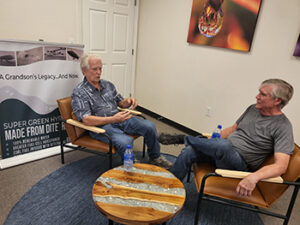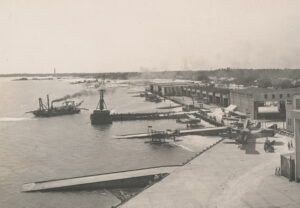 January 19, 2024 – AquaNew’s Rob Gourley recently sat down with his best childhood friend, Morgan Wesson, to reminisce about his grandfather, Richard Pass, who served in the U.S.Naval Aviation as a pilot during World War I. A video on their discussion plus samples of the historic photographs that Richard “captured in flight” on these experimental planes can be found at this link.
January 19, 2024 – AquaNew’s Rob Gourley recently sat down with his best childhood friend, Morgan Wesson, to reminisce about his grandfather, Richard Pass, who served in the U.S.Naval Aviation as a pilot during World War I. A video on their discussion plus samples of the historic photographs that Richard “captured in flight” on these experimental planes can be found at this link.
Photos Found in Closet Gathering Dust
Years before Lindbergh’s crossing of the Atlantic Ocean, U.S. military pilots were testing multiple planes including flying boat planes at the Naval Aviation base located in Pensacola, FL. Between 1916 and 1918, Pilot Richard Pass had an eye for photography and compiled many photos into an album that his grandchildren, including grandson Rob Gourley of Sarasota, FL., spent hours flipping through the pages years later. Rob’s wife, Dana, discovered the old album in the far reaches of Rob’s closet and she had never seen anything like them. It became part of the Gourleys’ bucket list to figure out the best way to conserve this amazing historic photo collection. After digitized copies were made, the original photos were professionally extracted from the old album and also have been conserved. Rob is considering if the full original photo collection should be donated to one museum archive or split the collection among two or more museums, preferably with a military flight interest.
They Were Nuts
In the video, Rob tells Morgan that his grandfather and the other pilots were “nuts” to fly these early experimental planes. The flying boat planes were rickety like flying a strawberry crate. Rob recalls his grandfather told him that the onboard repair kits for the flying boats consisted of banana glue, a roll of wire, pliers and New York Times newspaper because it was the thickest at the time. Richard photographed a number of plane crashes and some of those photos also appear in the video.
The Transatlantic Challenge
Near the end of WWI, the U.S. Navy accepted the international challenge to go for the first Transatlantic Flight. Rob also recalled that his grandfather told him that he came down with appendicitis the night before leaving on the journey. Four flying boat planes headed across the Atlantic Ocean from the United States but only one, the NC (Navy-Curtiss)-4 flying boat successfully completed the first Transatlantic Flight. The original NC-4 flying boat is on display at the Naval Aviation Museum in Pensacola, FL. (see photo below with Rob standing by the historic plane). Not only does the NC-4 have a mammoth size compared to the other planes in the museum’s collection, it also has the distinction of making the first successful transatlantic flight, 8 years before Lindbergh’s solo flight. It was a massive post-war effort in 1919 with dozens of Navy destroyers strategically placed in the Atlantic Ocean to allow refueling of the NC-4, sometimes only 30 minutes in the air before making another sea landing for the next refueling.
Decision on Where to Archive the Photos
If anyone has a recommendation on how to conserve this historic photo collection with a possible mobile public display to travel to multiple museums, let the Gourleys know (email robgourley@verizon.net).


